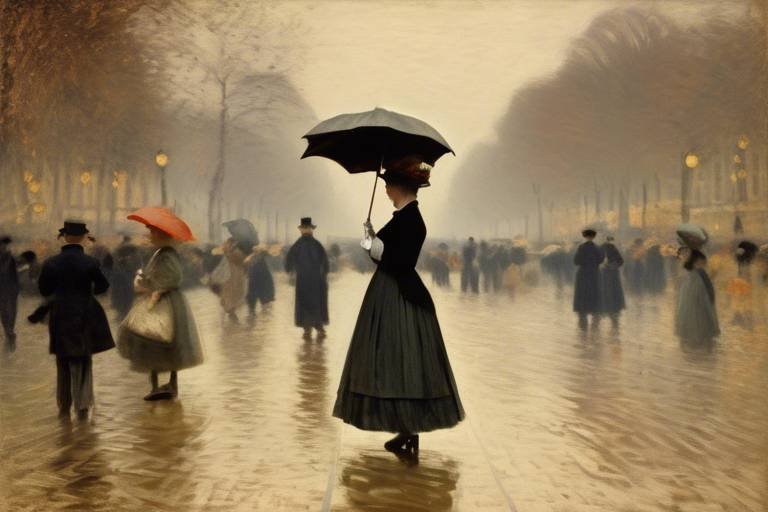The Aesthetics of Art in Ancient Egypt
The art of ancient Egypt is a mesmerizing tapestry of beauty, mystery, and symbolism that has fascinated the world for centuries. From the grandeur of pharaohs to the intricate details of hieroglyphs, Egyptian art is a reflection of a culture deeply rooted in spirituality and tradition. Each piece tells a story, not just of the artist's skill, but of the beliefs and values that shaped the civilization.
Symbolism lies at the heart of Egyptian art, with every element carefully chosen to convey deeper meanings. Animals like the sacred scarab beetle symbolize rebirth and regeneration, while colors such as blue and gold represent divinity and eternity. Hieroglyphs, the ancient Egyptian writing system, not only served a practical purpose but also held symbolic significance, often conveying religious or historical messages.
Ancient Egyptian artists were masters of their craft, utilizing a variety of materials and techniques to create enduring works of art. Sculpting in stone, painting on papyrus, and inlaying with precious metals like gold were common practices. The attention to detail and precision in their work is a testament to the skill and dedication of these artisans.
Religion played a central role in shaping Egyptian art, with depictions of gods, pharaohs, and rituals adorning temples and tombs. The belief in an afterlife fueled the creation of elaborate funerary art, such as tomb paintings, sarcophagi, and mummies, all designed to ensure a smooth passage to the next world.
Throughout different periods of Egyptian history, artistic styles and themes evolved, reflecting changes in society and rulers. The Amarna Period, under the reign of Akhenaten and Nefertiti, marked a departure from traditional art forms with its naturalistic depictions and emphasis on individuality.
The legacy of ancient Egyptian art endures to this day, influencing modern art, design, and architecture. From the geometric motifs of the Art Deco movement to the use of Egyptian motifs in contemporary fashion, the impact of this ancient civilization on the artistic world is undeniable.
Exploring the aesthetics of art in ancient Egypt is a journey into a world where beauty and symbolism intertwine, where every stroke of the brush and chisel carries with it a story of a civilization that continues to captivate and inspire.

Symbolism in Egyptian Art
Exploring the beauty and symbolism of art in ancient Egyptian culture, reflecting their beliefs, values, and artistic techniques that have captivated the world for centuries.
Symbolism in ancient Egyptian art is a complex and intriguing aspect that offers a glimpse into the profound beliefs and values of this ancient civilization. Each element and motif in Egyptian art carries symbolic significance, contributing to the overall narrative and spiritual essence of the artwork.
Animals played a crucial role in Egyptian symbolism, with each animal representing different qualities and characteristics. For example, the scarab beetle symbolized regeneration and rebirth, while the cat was associated with protection and fertility. These animal symbols were often incorporated into jewelry, amulets, and tomb decorations to convey specific meanings and offer spiritual protection.
Colors also held symbolic importance in Egyptian art, with each color representing different concepts and deities. For instance, the color blue symbolized the sky and eternity, while green represented fertility and rebirth. The use of vibrant colors in paintings and sculptures not only added aesthetic appeal but also conveyed deeper symbolic meanings that resonated with the spiritual beliefs of the ancient Egyptians.
Furthermore, hieroglyphs, the sacred writing system of ancient Egypt, were laden with symbolism. Each hieroglyphic symbol carried specific meanings and could be combined to form intricate messages and stories. The inclusion of hieroglyphs in art pieces added layers of meaning and significance, allowing artists to communicate with both the living and the divine realms.
Examining the materials and techniques employed by ancient Egyptian artists, including sculpting, painting, and the use of precious metals like gold.
Exploring how religious beliefs and practices influenced the creation of art in ancient Egypt, with a focus on depictions of gods, pharaohs, and the afterlife.
Investigating the significance of funerary art in ancient Egypt, including tomb paintings, sarcophagi, and mummies, and their role in ensuring a successful journey to the afterlife.
Tracing the development of artistic styles and themes in ancient Egyptian art over different periods, from the Early Dynastic Period to the Ptolemaic Period.
Examining the unique artistic style of the Amarna Period during the reign of Akhenaten and Nefertiti, characterized by naturalistic depictions and a break from traditional norms.
Discussing the enduring influence of ancient Egyptian art on modern art and design, from the Art Deco movement to contemporary fashion and architecture.

Materials and Techniques
When delving into the world of ancient Egyptian art, one cannot overlook the remarkable materials and techniques employed by the skilled artisans of that time. The Egyptians utilized a variety of mediums to create their masterpieces, with each material holding its own significance and contributing to the overall aesthetic appeal of the artwork.
One of the most iconic materials used in ancient Egyptian art was limestone, a soft and easily workable stone that was favored for sculptures and relief carvings. The artists also made extensive use of granite, a much harder stone, for more durable and long-lasting pieces. These stones were meticulously carved to depict gods, pharaohs, and mythical creatures with intricate details that still mesmerize viewers today.
Painting was another essential technique in Egyptian art, with artists using a vibrant palette of colors made from natural minerals like malachite, ochre, and lapis lazuli. These pigments were carefully applied to various surfaces, including walls, coffins, and papyrus scrolls, to create vivid and enduring images that told stories of the afterlife, mythology, and daily life.
Moreover, the Egyptians were skilled in the art of metalworking, particularly in the use of gold. Gold held immense symbolic value in ancient Egypt, representing the sun god Ra and the eternal life of the pharaohs. Gold leaf was meticulously applied to statues, jewelry, and funerary masks, adding a touch of luxury and divine radiance to the artworks.
Another noteworthy technique in ancient Egyptian art was the intricate process of inlaying precious stones and metals into objects, such as furniture and ceremonial items. This meticulous craftsmanship showcased the Egyptians' dedication to perfection and their belief in the importance of beauty and opulence in both life and death.
In conclusion, the materials and techniques used by ancient Egyptian artists were not only a testament to their exceptional skills but also a reflection of their reverence for the divine, their pursuit of immortality, and their desire to create enduring beauty that transcends time.

Religious Influence
Exploring the beauty and symbolism of art in ancient Egyptian culture, reflecting their beliefs, values, and artistic techniques that have captivated the world for centuries.
Understanding the deep symbolic meanings behind the various elements and motifs used in ancient Egyptian art, such as animals, colors, and hieroglyphs.
Examining the materials and techniques employed by ancient Egyptian artists, including sculpting, painting, and the use of precious metals like gold.
Religion played a central role in shaping ancient Egyptian art, with depictions of gods, pharaohs, and the afterlife being prominent themes. The art was not merely decorative but served a significant religious function. The Egyptians believed that art was a way to communicate with the divine and ensure the favor of the gods in both life and the afterlife. The intricate details in the artwork were not just for aesthetic purposes but held profound religious significance. For example, the portrayal of gods and goddesses in art served to honor and invoke their powers, while scenes depicting the journey to the afterlife guided the deceased on their spiritual voyage.
Investigating the significance of funerary art in ancient Egypt, including tomb paintings, sarcophagi, and mummies, and their role in ensuring a successful journey to the afterlife.
Tracing the development of artistic styles and themes in ancient Egyptian art over different periods, from the Early Dynastic Period to the Ptolemaic Period.
Examining the unique artistic style of the Amarna Period during the reign of Akhenaten and Nefertiti, characterized by naturalistic depictions and a break from traditional norms.
Discussing the enduring influence of ancient Egyptian art on modern art and design, from the Art Deco movement to contemporary fashion and architecture.

Funerary Art
Funerary art in ancient Egypt played a crucial role in ensuring a successful transition to the afterlife for the deceased. The elaborate and intricate tomb paintings, sarcophagi, and mummies were not merely decorative but held deep religious and symbolic significance. These artworks were believed to guide and protect the soul of the deceased in the journey to the afterlife, where they would be judged by the gods. The meticulous attention to detail in funerary art reflected the Egyptians' strong belief in the afterlife and the importance of preserving the physical body for eternity.

Artistic Evolution
Artistic Evolution in ancient Egyptian art is a fascinating journey through time that showcases the development of styles and themes over different periods. From the Early Dynastic Period to the Ptolemaic Period, Egyptian art underwent significant transformations, reflecting the changing political and cultural landscape of the civilization.
During the Early Dynastic Period, art in Egypt was characterized by a focus on simple forms and idealized representations of the human figure. Artists primarily worked with materials like limestone and wood, creating sculptures and reliefs that depicted pharaohs and deities in a formal and stylized manner.
As the civilization advanced into the Old Kingdom, artistic techniques became more refined, leading to the creation of monumental sculptures such as the famous Great Sphinx and the pyramids of Giza. These architectural marvels not only served as tombs for the pharaohs but also showcased the Egyptians' mastery of engineering and design.
The Middle Kingdom saw a shift towards more naturalistic representations in art, with a focus on capturing emotions and individual characteristics in statues and reliefs. Artists began experimenting with different materials and techniques, resulting in more lifelike depictions of human figures and scenes from daily life.
One of the most significant periods in Egyptian art history is the New Kingdom, known for its grand temples, elaborate tombs, and intricate wall paintings. The reign of Akhenaten and Nefertiti during the Amarna Period brought about a revolution in artistic style, with a departure from traditional norms towards a more naturalistic and intimate portrayal of the royal family.
By the time of the Ptolemaic Period, Egyptian art had assimilated various influences from foreign cultures, resulting in a fusion of styles and motifs. The art of this period reflects a cosmopolitan society where Greek, Roman, and Egyptian artistic traditions coexisted, creating a rich tapestry of artistic expression.
Overall, the artistic evolution of ancient Egyptian art is a testament to the creativity and ingenuity of a civilization that valued beauty, symbolism, and craftsmanship. Each period contributed to the rich tapestry of Egyptian art, leaving behind a legacy that continues to inspire and captivate audiences around the world.

Amarna Period
The Amarna Period in ancient Egypt, named after the capital city of Akhetaten, was a time of significant artistic innovation and religious revolution during the reign of Pharaoh Akhenaten and Queen Nefertiti. This period, spanning from approximately 1353 to 1336 BC, marked a departure from traditional artistic conventions and a shift towards a more naturalistic style.
One of the most distinctive features of the art from the Amarna Period is the portrayal of the royal family in a more relaxed and intimate manner. Unlike the rigid and idealized representations of previous pharaohs, Akhenaten and Nefertiti were depicted with elongated faces, slender bodies, and exaggerated features, reflecting a more humanistic approach to art.
The Amarna art style also emphasized a sense of movement and fluidity, with figures depicted in dynamic poses and naturalistic gestures. This departure from the static and formal compositions of earlier periods brought a sense of vitality and realism to Egyptian art.
Furthermore, the Amarna Period saw a shift in religious beliefs, with the pharaoh promoting the worship of the sun god Aten as the supreme deity. This monotheistic approach to religion was reflected in the art of the time, with depictions of the sun disc with rays extending down to touch the royal family, symbolizing divine favor and connection.
The Amarna art style was not limited to royal imagery but also extended to everyday scenes and objects, showcasing a more intimate and personal side of ancient Egyptian life. Scenes of domestic activities, nature, and religious rituals were depicted with a newfound sense of realism and emotion.
Despite its brief duration, the Amarna Period left a lasting impact on Egyptian art and influenced subsequent artistic styles. The naturalistic representations, expressive forms, and innovative techniques introduced during this period paved the way for artistic experimentation and creativity in later periods of Egyptian history.

Legacy of Egyptian Art
The legacy of Egyptian art is a testament to the enduring impact of ancient Egyptian culture on the world of art and design. From the intricate hieroglyphs adorning temple walls to the majestic statues of pharaohs, the art of ancient Egypt continues to inspire and fascinate artists and historians alike.
One of the most remarkable aspects of Egyptian art is its ability to transcend time and geography. The iconic images of gods and goddesses, the elaborate burial rituals, and the grand architecture of temples have left an indelible mark on art movements throughout history.
Modern artists and designers continue to draw inspiration from the aesthetic principles of ancient Egyptian art. The geometric shapes, bold colors, and intricate patterns found in Egyptian artifacts have influenced a wide range of artistic disciplines, from graphic design to interior decoration.
Moreover, the legacy of Egyptian art extends beyond the realm of visual arts. The mystique and allure of ancient Egypt have inspired literature, music, and even fashion. The timeless elegance of Egyptian motifs can be seen in haute couture collections and jewelry designs, adding a touch of exoticism and sophistication to contemporary styles.
As we marvel at the beauty and grandeur of ancient Egyptian art, we are reminded of the power of artistic expression to transcend cultural boundaries and speak to the universal human experience. The legacy of Egyptian art serves as a bridge between the past and the present, connecting us to a civilization that valued creativity, craftsmanship, and the eternal pursuit of beauty.
Frequently Asked Questions
- What is the significance of animals in ancient Egyptian art?
In ancient Egyptian art, animals held symbolic meanings representing various aspects of life, gods, and the afterlife. For example, the cat symbolized protection, the scarab beetle represented rebirth, and the falcon was associated with the god Horus.
- How did religious beliefs influence the art of ancient Egypt?
Religious beliefs played a significant role in shaping ancient Egyptian art. The depictions of gods, pharaohs, and scenes from the afterlife were common themes in art, reflecting the Egyptians' spiritual beliefs and practices.
- What materials were commonly used in ancient Egyptian art?
Ancient Egyptian artists utilized a variety of materials such as limestone, clay, papyrus, and precious metals like gold. These materials were used in sculpting, painting, and creating intricate jewelry and artifacts.
- How did funerary art contribute to ancient Egyptian beliefs?
Funerary art played a crucial role in ancient Egyptian beliefs about the afterlife. Tomb paintings, sarcophagi, and mummies were created to accompany the deceased on their journey to the afterlife, ensuring a successful transition and eternal existence.
- What is the legacy of ancient Egyptian art on modern culture?
Ancient Egyptian art has had a lasting impact on modern art and design. Its influence can be seen in various art movements, architectural styles, and fashion trends, showcasing the enduring appeal and timeless beauty of Egyptian artistic traditions.



















